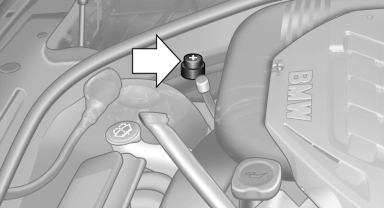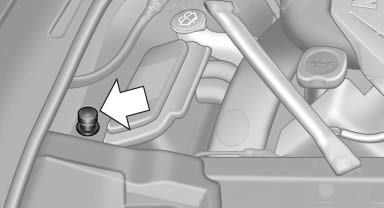Jump starting
Notes
If the battery is discharged, an engine can be started using the battery of another vehicle and two jumper cables. Only use jumper cables with fully insulated clamp handles.
To prevent personal injury or damage to both vehicles, adhere strictly to the following procedure.
![]() Do not touch live parts
Do not touch live parts
To avoid the risk of potentially fatal injury, always avoid all contact with electrical components while the engine is running.
Preparation
1. Check whether the battery of the other vehicle has a voltage of 12 volts. This information can be found on the battery.
2. Switch off the engine of the assisting vehicle.
3. Switch off any electronic systems/power consumers in both vehicles.
![]() Bodywork contact between vehicles
Bodywork contact between vehicles
Make sure that there is no contact between the bodywork of the two vehicles; otherwise, there is the danger of short circuits.
Starting aid terminals
![]() Connecting order
Connecting order
Connect the jumper cables in the correct order; otherwise, there is the danger of injury from sparking.

The so-called starting aid terminal in the engine compartment acts as the battery's positive terminal.

The body ground or a special nut acts as the negative terminal.
Connecting the cables
1. Pull off the cap of the BMW starting aid terminal.
2. Attach one terminal clamp of the positive
jumper cable to the positive terminal of the
battery, or to the corresponding starting aid
terminal of the vehicle providing assistance.
3. Attach the other end of the cable to the positive
terminal of the battery, or to the corresponding
starting aid terminal of the vehicle
to be started.
4. Attach one terminal clamp of the negative
jumper cable to the negative terminal of the
battery, or to the corresponding engine or
body ground of the vehicle providing assistance.
5. Attach the other end of the cable to the negative
terminal of the battery, or to the corresponding
engine or body ground of the vehicle
to be started.
Starting the engine
Never use spray fluids to start the engine.
1. Start the engine of the assisting vehicle and
let it run for several minutes at an increased
idle speed.
If the vehicle being started has a diesel engine:
let the engine of the assisting vehicle
run for approx. 10 minutes.
2. Start the engine of the vehicle being started
in the usual way.
If the first starting attempt is not successful,
wait a few minutes before making another
attempt in order to allow the discharged battery
to recharge.
3. Let both engines run for several minutes.
4. Disconnect the jumper cables in the reverse
order.
Check the battery and recharge if necessary.
See also:
Locking the doors andwindows
Rear doors
Push the locking lever on the rear doors down.
The door can now be opened from the outside
only.
Safety switch for the rear
Press the button on the driver's
door if
children ar ...
Overview, instrument cluster with enhanced features
Overview, instrument cluster with enhanced features
1 Time
External temperature
Date
Selection list, e.g., radio
Sp ...
The concept
Personal Profile concept
You can set several of your vehicle's functions
to suit your personal needs and preferences.
► The settings are automatically saved in the
profile currently activa ...
